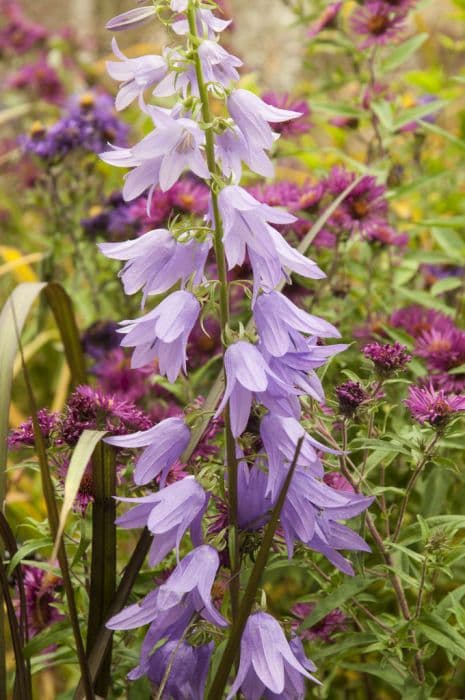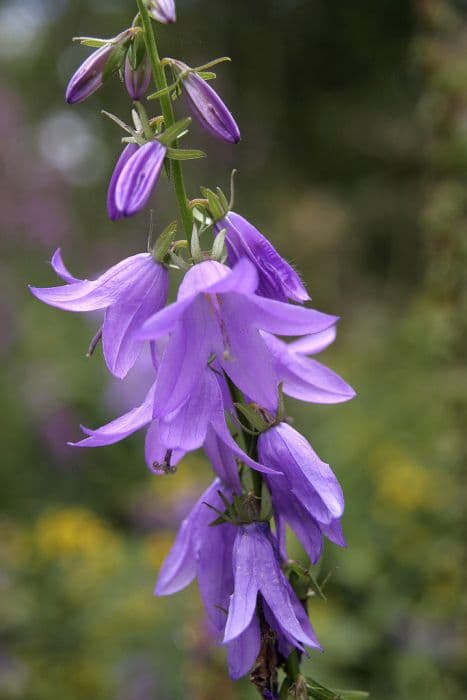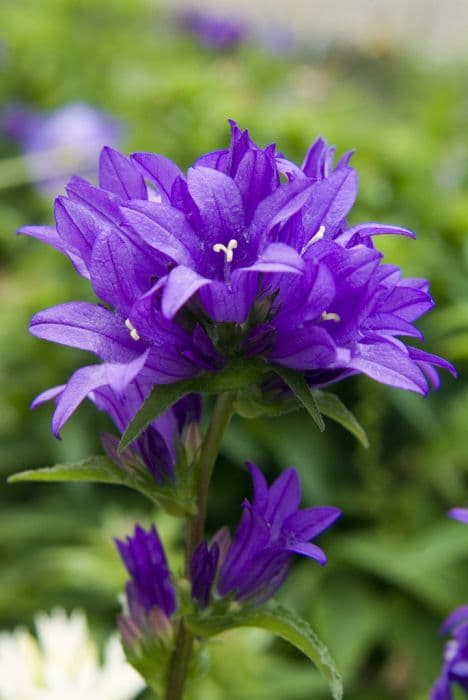Fairy Thimbles Campanula cochlearifolia 'Elizabeth Oliver' (d)

ABOUT
Elizabeth Oliver is a charming variety of the common bellflower with an attractive appearance. It features clusters of delicate, double flowers that have a distinctive bell-like shape, which is characteristic of bellflowers. The blooms are usually a soft blue or lavender hue, exuding a gentle and soothing look. The petals have a slightly ruffled or frilly edge that adds to the ornamental appeal of the flower. The foliage of Elizabeth Oliver is green and typically consists of small, rounded or heart-shaped leaves that provide a nice contrast to the light-colored flowers. The leaves are arranged along the stems and may have a slight serration or smooth edges, looking fresh and lush during the growing season. This bellflower variety forms a low-growing mound of foliage that is aesthetically pleasing and often used in garden borders or as groundcover. Its delicate blooms and rich green leaves make it an attractive choice for ornamental gardening, containers, and rock gardens, where it adds a touch of grace and charm. The flowering season of Elizabeth Oliver usually spans the summer months, when it can be seen in its full glory, with a profusion of flowers decorating the plant.
About this plant
 Names
NamesFamily
Campanulaceae
Synonyms
Fairies' Thimbles, Tiny Bells, Dwarf Bellflower, Elizabeth Oliver Bellflower
Common names
Campanula cochlearifolia 'Elizabeth Oliver'
 Toxicity
ToxicityTo humans
Campanula, commonly known as bellflower, generally is not considered toxic to humans, and there is no widely known toxicity associated with Campanula cochlearifolia 'Elizabeth Oliver'. However, it is always advisable to avoid ingesting any part of ornamental plants due to potential individual allergies or stomach upset.
To pets
The bellflower is not known to be toxic to pets, including cats and dogs. Therefore, Campanula cochlearifolia 'Elizabeth Oliver' is considered safe, and there are no commonly reported symptoms of poisoning from this plant in pets. Still, it's always best to prevent pets from eating plants as a precaution.
 Characteristics
CharacteristicsLife cycle
Perennials
Foliage type
Deciduous
Color of leaves
Green
Flower color
Blue
Height
0.5 feet (15 cm)
Spread
1 feet (30 cm)
Plant type
Herb
Hardiness zones
3
Native area
Europe
Benefits
 General Benefits
General Benefits- Aesthetic Appeal: The fairy thimble provides delicate, nodding bell-shaped flowers adding a charming touch to gardens.
- Attracts Pollinators: The blooms attract beneficial insects such as bees and butterflies, promoting pollination in the garden.
- Ground Cover: Due to its low-growing habit, fairy thimble can effectively cover bare spots and suppress weeds.
- Rock Gardens: This plant is an excellent choice for rock gardens due to its preference for well-drained soils and its cascading foliage.
- Border Planting: Fairy thimble can be used to create beautiful edges along pathways or flower beds.
- Container Gardening: It's suitable for growing in containers or hanging baskets, offering flexibility in garden design.
- Easy to Grow: Fairy thimble is beginner-friendly, requiring minimal maintenance and being relatively disease-free.
- Perennial Growth: As a perennial, it returns year after year, offering long-term garden presence and reduced replanting.
 Medical Properties
Medical PropertiesThis plant is not used for medical purposes.
 Air-purifying Qualities
Air-purifying QualitiesThis plant is not specifically known for air purifying qualities.
 Other Uses
Other Uses- Fairy Garden Planting: The Campanula cochlearifolia 'Elizabeth Oliver' or fairy thimble, is often used in miniature fairy gardens due to its small size and delicate flowers, creating a whimsical environment.
- Photography Prop: The dainty blooms of the fairy thimble can serve as a charming backdrop or focal point in close-up photography and macro photography, enhancing the aesthetic appeal of the images.
- Edible Garnish: While not commonly known for their edibility, the blossoms can be used as an edible garnish to decorate salads and desserts with a touch of color.
- Jewelry Inspiration: Jewelers might take inspiration from the intricate shape and beauty of the fairy thimbles, designing pieces that mimic their form and delicate nature.
- Art and Crafts: The tiny blossoms are sometimes used in dried flower arrangements or pressed flower art, providing a natural element to handmade greeting cards, bookmarks, or other crafts.
- Educational Tool: In botanical education, the fairy thimble can be used to teach children and students about plant life cycles, pollination, and alpine flora.
- Color Dye Source: Though not commonly used for dyeing, the petals could potentially be used as a natural source of dye for small craft projects, producing soft, pastel colors.
- Ice Cube Embellishments: Petals of the fairy thimble can be frozen in ice cubes to create decorative elements for summer drinks and cocktails, adding a touch of elegance to beverages.
- Cake Decoration: Fresh, pesticide-free blooms can be used in cake decoration for a rustic or garden-themed cake, particularly for weddings or garden parties.
- Floral Confetti: Dried petals can be scattered as natural, biodegradable confetti at celebrations, especially eco-friendly weddings or outdoor events.
Interesting Facts
 Feng Shui
Feng ShuiThe Fairies' Thimbles is not used in Feng Shui practice.
 Zodiac Sign Compitability
Zodiac Sign CompitabilityThe Fairies' Thimbles is not used in astrology practice.
 Plant Symbolism
Plant Symbolism- Gratitude: Campanula flowers, known as bellflowers, often symbolize gratitude due to their bell shape, which appears to be offering thanks as it hangs with a graceful nod.
- Constancy and Perseverance: The bellflower's ability to grow in rocky areas and thrive in challenging conditions makes it a representation of steadfastness and determination.
- Unwavering Love: The bellflower's enduring bloom and consistent flowering can be associated with unchanging and everlasting love, making it a favorite in romantic contexts.
- Vulnerability: Despite their resilient habits, the delicate appearance of these flowers can signify vulnerability and the need for care in relationships.
 Water
WaterThe Fairy Thimble should be watered regularly to maintain moist soil, especially during the growing season in spring and summer. An ideal approach is to water this plant once or twice a week, depending on the climate and weather conditions. If the top inch of soil feels dry, it's time to water. Provide the plant with approximately 16 to 24 ounces of water per session, ensuring even soil moisture without waterlogging. During the fall and winter months, reduce watering frequency as the plant's growth slows down.
 Light
LightThe Fairy Thimble thrives best in partial shade to full sun conditions. It's important to place the plant in a spot where it can receive bright, indirect light for most of the day. If outdoors, a location that offers morning sun and afternoon shade would be ideal to protect it from the intense heat of the midday sun.
 Temperature
TemperatureThe Fairy Thimble does well in a temperature range between 50°F and 75°F, making it suitable for temperate climates. It can survive temperature dips down to around 30°F but should be protected from frost. Ideally, keep this plant in an environment where it is not exposed to temperature extremes, as consistent temperatures within the aforementioned range promote healthy growth.
 Pruning
PruningPrune the Fairy Thimble regularly to remove dead or faded flowers, which encourages further blooming and maintains the plant's tidy appearance. Light pruning can be done throughout the flowering season. More extensive pruning should be carried out in late winter or early spring to prepare the plant for new growth. During pruning sessions, cut back any dead or damaged foliage and shape the plant as desired.
 Cleaning
CleaningAs needed
 Soil
SoilFairy Bells thrive in a well-draining, loamy soil mix with a pH range of 6.0 to 7.5. A mix of two parts garden soil, one part peat moss, and one part perlite or coarse sand is ideal. Ensure that the soil is fertile by incorporating compost or a balanced, slow-release fertilizer to support bloom production.
 Repotting
RepottingFairy Bells should be repotted every 2-3 years or when the plant has outgrown its current container. They prefer to be a bit root-bound, so repotting should be done infrequently and increased pot size should be minimal.
 Humidity & Misting
Humidity & MistingFairy Bells prefer moderate humidity levels but are adaptable to a range of household humidity conditions. It is important to replicate outdoor humidity as closely as possible, generally aiming for 40-60% relative humidity.
 Suitable locations
Suitable locationsIndoor
Place in bright, indirect light; water moderately.
Outdoor
Provide partial shade, protect from intense sun and wind.
Hardiness zone
3-9 USDA
 Life cycle
Life cycle'Elizabeth Oliver' Fairy Thimbles, a variety of Campanula cochlearifolia, begins its life cycle as a seed, which germinates in spring under appropriate conditions of moisture and temperature. The seedlings develop into a low-growing, mat-forming perennial with heart-shaped, basal leaves. During late spring and early summer, the plant puts forth its characteristic bell-shaped, lavender-blue flowers on short upright stems. After pollination, often by bees and other insects, the flowers produce small capsules containing seeds, which will disperse to give rise to new plants. As autumn approaches, the foliage may die back, with the plant entering a period of dormancy during winter, especially in cold climates. The plant resumes growth in the following spring, thereby completing its life cycle and potentially spreading within the garden through self-seeding.
 Propogation
PropogationPropogation time
Spring-Early Summer
The Fairy Thimble, also known as Campanula cochlearifolia 'Elizabeth Oliver', can be propagated through division, which is the most popular method for this perennial plant. The best time to divide Fairy Thimble is in early spring or after the blooming period in late summer to early fall. To propagate by division, gently lift the plant from the ground with a garden fork, ensuring a good amount of roots comes with each clump. Gently tease apart the roots to create smaller clumps with two or three shoots each. Replant these divisions at the same depth they were originally growing, spacing them about 9 to 12 inches (approximately 23 to 30 centimeters) apart to allow for adequate growth. Water the new divisions well to help establish them. This method of propagation not only helps to rejuvenate older clumps that may have become woody or less vigorous but also allows gardeners to expand their collection or share with others.








